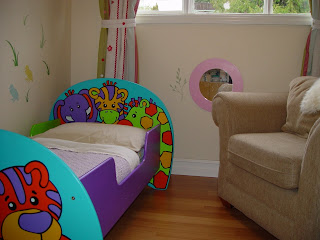A. is a three year old boy who has been coming to our school for the past year. He has a little sister, F. who (I think) is 2. A.'s mother was a Montessori student right up into high school so a lot of this came naturally to her. A big thanks goes out to the whole family for sharing some great photos of their home.
This is A.'s bedroom. The big chair is where he and his Mom or Dad read stories.
Another wall of A.'s bedroom. All his things are organized into boxes that he can easily see into and remove by himself. All of the pictures are low enough that he can view them and there is a low mirror available to him. Just as toddlers like to explore their faces, so do older children. Mirrors allow them to explore facial expressions and help to foster self-awareness.
And here is A.'s closet. His parents have fitted it with a low shelf so that two choices of clothes are within his reach. This allows him the independence of choosing his own clothes yet doesn't overwhelm him by giving too many choices.
This is F.'s room. She also has a little mirror at her eye level and another big chair for reading stories or just for curling up in.
These are F.'s shelves. Just like in A.'s room, these shelves have been set up so that F. can see what she wants and easily get to it. The shelves are not overcrowded and there are only a few things in total. This facilitates her putting things back once she's finished with them. However, at this age, most children will need lots of guidance and help putting things back when they are done.
In the dining room is a small table where the children can play and make art.
Both children have shelves for their toys in the livingroom.
A question that often comes up in families with more than one child is how to keep the younger one out of the older one's toys. In a lot of cases, I don't think you can unless you are willing to take some of the independence away and put the toys in question out of reach. However, it make more sense (from an independence point of view) to mirror the lesson that our children learn in the classroom. That one may not touch another's work and that an activity must be put back on the shelf when finished.
The next time you observe in your child's classroom, watch how the teachers guide the children to return activities to the shelves. Sometimes it will be a simple touch on the shoulder and an indication to the shelf. Other times it will be more direct "You seem to be finished with this activity. Would you like some help putting it back on the shelf?"
One mother has solved this problem by consulting with her older child. The toys that the child is willing to share with her sibling are kept in the livingroom. Those toys that are precious and are not to be shared are kept in the little girl's closet on a low shelf. The door to the closet can be opened by the older child but not by the younger one. A perfect solution.









Hi Cynthia! F. will be 2 in May, and everything has certainly been easier since she has been nearing 2. I think she enjoy's putting her toys back more than A.! Thank you for all your help in empowering our children in their home environment:)
ReplyDeleteYou are very welcome! Thanks for sharing your pictures.
ReplyDelete